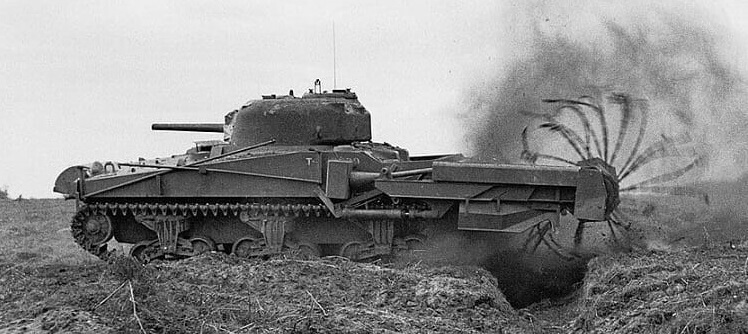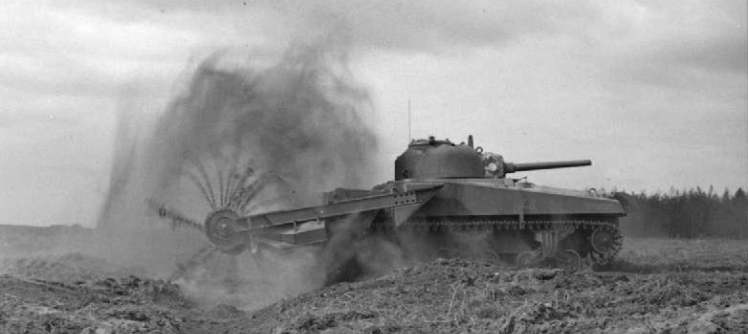Commanders!
Warfare is renowned for bringing accelerated innovation, growth, and technologies to the world scene—from medicine progression and the emancipation of women to aircraft agility in the skies and nuclear exploration among the great powers.
Hobart's 'Funnies'—Allied vehicles designed and adapted by British Major General Percy Hobart—fit this category perfectly. These mighty machines rolled out of Allied landing ships and planes with equipment ready to assist a successful D-Day invasion. If you're unfamiliar with these curious contraptions—from waterproof skirts and propellers to flamethrowers and minesweeping apparatus—you're in for a treat.
We've taken a look at what made these unique vehicle adaptions so influential on the Normandy beaches and beyond. So adorn your history hats and read on to find out more!
A Flamethrowing Terror
Introducing perhaps the most famous modification of the Churchill Mark IV and beyond—the 'Crocodile' flamethrower. An armored towed trailer fuelled the flames that could shoot over a range of 80 meters and proved an efficient means of clearing bunkers, trenches, and other fortifications.
A Psychological Weapon
It was actively used by the American soldiers and proved a hellish psychological weapon against German troops hunkered in their bunkers. Many reports suggest they surrendered once they saw the fire-breathing Churchill creeping toward them. Sometimes crews would spray a "wet squirt" or "wet shot" of fuel to warn enemies and give them a chance to surrender.
A Terrifying HE Mortar
In this AVRE (Assault Vehicle Royal Engineers) variation, the Churchill's main gun was replaced with a 290 mm Petard spigot mortar, capable of firing a 40 lb (18 kg) HE shell over 100 meters. Scarily for the crews, it had to be reloaded externally by opening a hatch and sliding a round into the mortar tube from the hull. Nicknamed the "flying dustbin," it proved successful in destroying concrete bunkers and roadblocks as the Allies advanced.
Variations on Variations
Specialized equipment could be added to these tanks in several 'child' variations of the already-adapted AVRE, including the Churchill AVRE Bobbin, which is discussed below.
A Path Layer
This AVRE-adapted Churchill was adapted to lay reinforced canvas matting down over soft sand and terrain that could otherwise not support the weight of other armored vehicles.
A Canvas Road
This variation was equipped with a reel of 3 meters wide canvas cloth reinforced with steel poles that could roll a makeshift road over 100 meters.
The Armoured Ramp Carrier (ARK)
A turretless Churchill tank was modified with extendable ramps at either end so other vehicles could scale obstacles, effectively acting as a mobile bridge.
Fascines
Fascines—large bundles of wooden sticks and meshed brushwood—could bridge trenches and gabs in the ground for infantry and vehicles to cross. They were first used during the First World War but were brought back nearly 30 years later, ahead of the D-Day invasion.
Bridge Layers
Officially known as 'Small Box Girders,' these 9-meter bridges could span trenches, gabs, and rivers and scale walls up to 4.5 meters high. They were often used in conjunction with Fascines and could be deployed within 30 seconds.
A Demolition Double
Two (or occasionally more) demolition charges were added to a metal frame of a Churchill tank. The tank was then placed against a concrete wall and detonated by the tank driver from a safe distance.
A Concrete Crusher
The explosions were intended to rock concrete emplacements, beach obstacles, and sea walls. However, it is uncertain whether the 'Double Onions' were deployed during D-Day, as crews were not particularly keen on being around it—given concerns that incoming rounds might accidentally trigger the explosives.
A Minesweeper
The 'Crab' vehicles comprised a Sherman tank equipped with a mine flail—essentially a rotating cylinder of heavy chains—that cleared mines for Allied troops to advance safely.
A Versatile Fighter
The 75 mm gun was also retained so it could be fired when the flail was not in use. It was turned away from the flail when in use but could be repositioned and loaded to provide further infantry support.
The Bullhorn Plough
The 'Bullhorn Plough' was a slight variation that excavated the ground in front of the tank to expose any land mines.
An Amphibious Adaption
The 'swimming' M4A1 or M4A4 Sherman—also known as the Duplex Drive or DD Tank—was an amphibious tank used on all five beaches on D-Day. A Sherman tank was modified to feature a canvas flotation screen for buoyancy with propellers powered by a Duplex Drive system.
Launchable From Sea
It was launched from a landing craft up to several miles from the beach, able to support its weight in water, and then the screens were dropped once ashore to provide immediate infantry support. The Buffalo LVT (Landing Vehicle Tracked) was a similar amphibious vehicle that also demonstrated an efficient way to transport troops, small vehicles, and supplies.
Designed to Clear the Way
These 'Funnies' kept the invasion beaches tidy of obstacles and rubble and filled in bomb craters and anti-tank ditches.
Additional Armor
A conventional Caterpillar D7 bulldozer was kitted out with additional metal and armor to protect the driver and the engine.
A Step Up from the Rest
A Cromwell tank was also stripped apart and remodeled to include a bulldozer blade. The well-armored machine could keep up with tank formations and be used to clear obstacles in Belgium toward the end of 1944.
A Secret Weapon
This AVRE/Grant-based variation was deliberately named inaccurately to maintain its secrecy. Contrary to its name, it wasn't primarily designed to defend canals. Instead, a specially-modified turret featured a powerful carbon-arc searchlight that could illuminate enemy positions during night attacks.
Indirect Artificial Light
While it may not have seen action on D-Day, it was later used to produce a powerful artificial light designed to dazzle German defenders.
D-Day Missions and Sales: Historical Vehicles and Customizations

Available from June 6 at 07:00 CEST through June 13 at 07:00 CEST (UTC+2)
Missions and Rewards
Take on the D-Day-themed missions on the Utah and Sword beaches and collect inscriptions and styles—including the Overlord 2D style! Hit the first button below to see the mission conditions and the customizations in all their glory.
Commemorative Themed Sales
Expand your collection with three historical vehicles and three exclusive styles available in the Premium Shop! Pick up individual packages or the discounted D-Day Bundle with the
 VI
VI
Bretagne Panther
,
 VI
VI
M4A3E8 Thunderbolt VII
,
 V
V
M10 RBFM
, and more!
We hope you enjoyed your history lesson, Commanders! Now go grab your discounted offers and roll out with our D-Day missions!


.png)


.png)











_v2.png)

